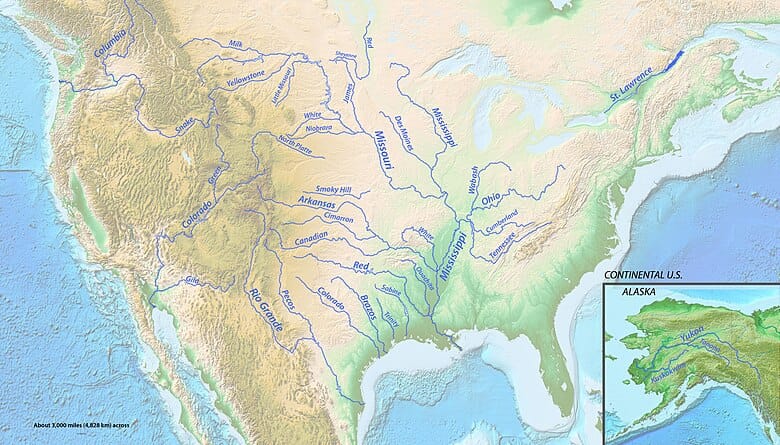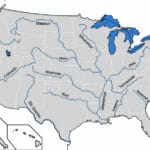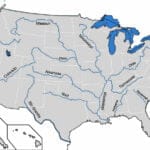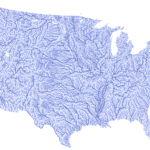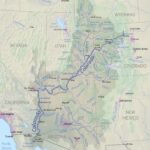Hey there, river enthusiasts! Get ready for a wild ride down some of America’s most epic waterways. We’re talking about the giants that carve through the land and leave a lasting mark on our country’s history. From the mighty Mississippi to the untamed Yukon, each river has a story to tell. Along the way, we’ll dive into how they’ve shaped our lives, from transportation to food to the homes of all kinds of creatures. Join us as we explore these aquatic wonders and discover the unique tales they have to share.
5 Biggest Rivers in the US
The United States, a land of diverse landscapes, boasts 38 rivers with main stems exceeding 500 miles in length. These rivers, collectively spanning over 15,000 miles, play a crucial role in shaping the nation’s geography, economy, and history. Flowing through it all are some mighty impressive rivers, each with its own story to tell. Let’s take a journey down the currents of the five longest rivers in the US, exploring their impact on the environment and the people who live along their banks.
1. The Mighty Missouri: King of the Rivers
Stretching a whopping 2,540 miles, the Missouri River holds the crown as the longest river in the US. It begins its journey high in the Rocky Mountains of Montana, where three source streams converge to form its headwaters. The longest of these streams originates near Brower’s Spring, joined by the Firehole River and the Gallatin River, embarking on an epic journey eastward and southward. The Missouri eventually meets up with the Mississippi River near St. Louis, Missouri, but not before leaving its mark on ten states and draining an area larger than California, Texas, and Montana combined!
The Missouri has long been a vital waterway for transportation, carrying goods and people across the country. Native American tribes relied on it for centuries, and later, fur traders and explorers paddled their way up and down its currents. Today, barges laden with agricultural products still navigate its waters, showcasing its continued importance to commerce and trade.
2. The Mississippi: Father of Waters
The Mississippi River, often called the “Father of Waters,” flows a remarkable 2,350 miles, securing its place as the second longest river in the US. Its headwaters lie in Lake Itasca, Minnesota, and from there, it embarks on a journey south, cutting through the heartland of America before emptying into the Gulf of Mexico.
The Mississippi River basin is a sprawling network of rivers and streams, covering over 1.2 million square miles and encompassing parts of 32 states! This makes it one of the largest watersheds in the world, supporting a staggering amount of biodiversity. The river has been a source of life and inspiration for countless generations, shaping the history, culture, and economy of the regions it traverses.
3. The Wild Yukon: An Alaskan Giant
Venturing north, we encounter the Yukon River, a behemoth flowing 1,980 miles through the rugged beauty of Alaska. Originating in British Columbia, Canada, the Yukon carves its path through remote wilderness, offering a glimpse into a world untouched by time.
Known for its powerful currents and breathtaking scenery, the Yukon River has long been a vital resource for the indigenous communities who call this region home. Salmon, a cornerstone of their culture and sustenance, make their way upstream each year to spawn, continuing a cycle that has sustained life for millennia.
4. The Colorado: Carving Through Time
The Colorado River, a 1,450-mile-long marvel, is famous for its dramatic canyons and whitewater rapids. Its journey begins in the Rocky Mountains of Colorado and winds its way southwest, carving through layers of rock to create some of the most iconic landscapes in the world, including the Grand Canyon.
While the Colorado River might not be the longest, it’s certainly one of the most influential. Its waters sustain life in seven US states and even reach into Mexico, providing a lifeline for millions of people and vast agricultural lands in an otherwise arid environment. However, the increasing demand for water in the region has also sparked debates about conservation and responsible water management, highlighting the challenges of balancing human needs with environmental sustainability.
5. The Ohio: A Tributary with a Big Role
The Ohio River, a significant tributary of the mighty Mississippi, flows for 981 miles, connecting communities and industries across six states. It begins at the confluence of the Allegheny and Monongahela Rivers in Pittsburgh, Pennsylvania, and eventually joins the Mississippi River near Cairo, Illinois.
The Ohio River played a pivotal role in the westward expansion of the United States, serving as a major transportation route for settlers, goods, and raw materials. Today, it remains a vital waterway for commerce, but it also faces challenges from pollution and habitat degradation, emphasizing the importance of protecting this vital resource for future generations.
These five magnificent rivers are just a glimpse into the vast and intricate network of waterways that crisscross the United States. They are much more than just bodies of water; they are lifelines, shaping the land, influencing history, and continuing to inspire awe and wonder in all who encounter their power and beauty.
What Defines the Biggest Rivers in the US? – Beyond Just Length
We often hear about the “longest” rivers, with the Mississippi River, at a staggering 2,341 miles, often taking the spotlight. However, a river’s grandeur extends far beyond its length, encompassing factors that contribute to its power and ecological significance.
It’s Not Just About the Miles:
While length is a factor, it doesn’t paint the complete picture. Imagine two rivers: one long and narrow, meandering lazily, and another, shorter but wider and deeper, with a more robust flow. The latter, despite its shorter length, might carry a larger volume of water, shaping the landscape more dramatically.
Factors That Determine a River’s Significance:
1. Discharge: The River’s Heartbeat
Discharge refers to the volume of water flowing through a river at a given time. It’s a measure of the river’s lifeblood, influencing its ability to shape landscapes, support ecosystems, and provide resources. The Columbia River, for instance, is renowned for its powerful discharge, carving out canyons and nurturing fertile valleys.
2. Watershed: The River’s Catchment Area
Every river has a watershed – the surrounding land that drains into it. A larger watershed means more water feeds the river, increasing its flow and impacting its ecological influence. The Mississippi River boasts a vast watershed encompassing over 31 states, showcasing its far-reaching impact.
Rivers Without Borders:
Rivers often transcend political boundaries, flowing freely across landscapes. In the US, several major rivers, including the Red River of the North and the Milk River, extend into Canada. Similarly, the Columbia and Yukon Rivers originate in Canada before gracing the US with their presence.
Humans and Rivers: A Complex Relationship:
Human activities, such as dam construction and water diversions, can significantly alter a river’s natural flow and length. While these alterations may offer benefits, they often come at a cost, impacting the river’s health and the communities reliant on it. Finding a balance between human needs and environmental preservation remains an ongoing challenge.
The Mighty Mississippi – Unveiling the Largest River System in the US
The Mississippi River, more than just a river, is a colossal force shaping the American landscape and history. Stretching over 2,550 miles, it claims the title of North America’s longest river and earns a prominent place among the world’s most significant waterways.
From Humble Beginnings to a Mighty Force:
The Mississippi River’s journey begins as a humble stream, fed by melting glaciers. As it flows southward, it gathers momentum, its flow growing like an avalanche. It meanders through diverse landscapes, from dense forests to vast prairies, leaving an indelible mark on the land.
Shaping History and Culture:
Throughout history, the Mississippi River has been a lifeline for countless communities. Native American tribes depended on it for sustenance and transportation, navigating its waters in canoes. European explorers recognized its strategic importance, using it to unlock the continent’s interior. The river played a pivotal role in westward expansion, serving as a liquid highway for pioneers seeking new beginnings. Steamboats, laden with dreams and possibilities, became symbols of progress and change.
An Economic and Ecological Powerhouse:
Even today, the Mississippi River remains the lifeblood of the nation. Barges laden with goods traverse its waters, connecting bustling cities and fueling industries. Its vast watershed, encompassing 1.2 million square miles, supports a remarkable diversity of habitats. Towering forests, sprawling farmlands, and vibrant wetlands all contribute to the Mississippi’s ecological richness. The river’s biodiversity is astounding, hosting over 3,000 species of plants and animals.
Conservation Efforts: Protecting a National Treasure:
Recognizing the Mississippi River’s invaluable importance, conservation efforts are underway to protect its health and ensure its vitality for future generations. Initiatives focus on reducing pollution, restoring degraded habitats, and managing water resources responsibly.
The Missouri River – A Journey Down the Longest US Waterway
The Missouri River, stretching an impressive 2,341 miles, claims the title of the longest river in the United States. From its headwaters in the Rocky Mountains to its confluence with the Mississippi River, the Missouri’s journey is nothing short of remarkable.
A River of Immense Scale:
The Missouri River’s headwaters originate from three streams nestled in the Centennial Mountains of Montana. The longest of these streams arises near Brower’s Spring, eventually merging with the Firehole River and the Gallatin River to form the mighty Missouri. As the river flows eastward and then southward, it traverses a remarkable variety of landscapes, showcasing the vastness of the American West.
The Missouri River Basin, encompassing a staggering 529,350 square miles, dwarfs many US states in size. This expansive basin, covering nearly one-sixth of the country’s landmass, highlights the Missouri’s far-reaching influence on the landscape.
A Historical Highway:
The Missouri River’s historical significance is as impressive as its size. In the 17th century, European explorers like Louis Jolliet and Jacques Marquette embarked on daring expeditions to chart its course. Their journeys unveiled the river’s potential as a transportation route and opened up new possibilities for trade and settlement. The fur trade, a defining aspect of early American commerce, relied heavily on the Missouri River as a conduit for transporting valuable furs from the Rocky Mountains to eastern markets.
During the westward expansion, the Missouri River became a lifeline for pioneers, carrying them and their dreams toward new lives. Steamboats, symbols of progress and ambition, plied its waters, facilitating the movement of people, goods, and ideas. The river’s role in shaping the American West cannot be overstated.
Balancing Progress and Preservation:
The late 19th and early 20th centuries witnessed a surge in dam construction along the Missouri River. These dams aimed to control flooding, provide irrigation, and generate hydroelectric power. While these projects offered benefits, they also altered the river’s natural flow and impacted its delicate ecosystem. As a result, approximately 35% of the Missouri River’s natural course has been modified.
Recognizing the need to balance human needs with environmental preservation, ongoing efforts focus on mitigating the impacts of dam construction and restoring the river’s health. Conservation initiatives aim to protect endangered species like the sturgeon and pallid sturgeon, ensuring their survival for future generations.
A Vital Resource:
Despite the challenges, the Missouri River remains a vital resource for millions of people. Its waters irrigate vast agricultural lands, ensuring food security. Many communities rely on the river for their drinking water supply. The dams, while altering the river’s natural flow, generate substantial hydroelectric power, reducing reliance on fossil fuels. In addition, the reservoirs created by the dams offer recreational opportunities, drawing visitors seeking to fish, boat, and enjoy the beauty of nature.
As we conclude our journey down America’s longest rivers, let’s remember that they are more than just bodies of water. They are dynamic ecosystems, historical corridors, and sources of life. Understanding their significance and the challenges they face is crucial for ensuring their health and appreciating their role in shaping our nation. Let this exploration inspire a deeper appreciation for these natural wonders and fuel our commitment to preserving them for generations to come.
For more insights into the fascinating world of rivers, explore:
- The longest rivers in Canada
- The many main rivers in Canada
- The longest lake in the US
- Unveiling Bernhard Caesar Einstein’s Scientific Achievements: A Legacy in Engineering - July 15, 2025
- Uncover who is Jerry McSorley: CEO, Family Man, Business Success Story - July 15, 2025
- Discover Bernhard Caesar Einstein’s Scientific Contributions: Unveiling a Legacy Beyond Einstein - July 15, 2025
